Last Updated on March 10, 2025 by Owen McGab Enaohwo

Do you also fall within the 74% of small law firms that spend more time performing administrative tasks than actually practicing law?
Would you like to be able to get more practice-related work done at your firm instead?
Then, read every word in this article because you’ll be equipped with the knowledge and tools you need to manage your small law firm like a pro by the end. Your operations will run smoothly, and you’ll have all the time and support you need to make your clients happy.
A little spoiler: One great way to effectively manage a small law firm’s operations and start seeing improved results almost immediately is to use SweetProcess to streamline your business operations.
With SweetProcess, you can document your processes and encourage smoother collaboration with your team, improving productivity and the smooth running of your small law firm.
The good thing is that you can try SweetProcess without any commitments, and you get more than enough time to see if it really works to improve your business operations. Then, you can decide whether to commit fully to it.
Simply click here to get a free 14-day trial of SweetProcess. You don’t even have to put your credit card on file for this trial.
What You’ll Learn In This Guide
Why Is Effective Operations Management Essential for Small Law Firms?
How to Manage a Small Law Firm: 7 Key Strategies for Success
How to Manage Your Small Law Firm Operations Using SweetProcess
Why These Law Firms Chose SweetProcess to Manage Their Legal Operations
Tips & Best Practices for Effective Law Firm Management
Set Your Law Firm up for Success With SweetProcess
Why Is Effective Operations Management Essential for Small Law Firms?
Managing a small law firm goes beyond just legal expertise; it’s more about creating a system that allows your firm to function smoothly and achieve consistent success and sustainable growth. The foundation for this is effective operations management, as this helps you overcome the common challenges small law firms face. Be it improved client satisfaction or productivity and everything in between, effective management ensures your small law firm remains competitive in such a demanding industry.
Below are a few reasons effective operations management is essential for law firms:
1. Cost Control

One of the biggest challenges faced by small law firms is managing their finances. Despite the limited resources usually available to a firm of that size, it’s easy to fall into the trap of overspending on unnecessary expenses, and this can easily lead to financial strain.
With a proven system in place to effectively manage the operations of a law firm, they are provided with tools and strategies to set budgets, track their spending, and thereby reduce waste.
Managing your small law firm operations effectively will allow you to control your costs and cut down on excesses. It also inspires practical ways to save money, like negotiating better rates with vendors or switching to cost-effective alternatives.
Managing your small law firm effectively can also lead to other cost-controlling steps like automating repetitive tasks and reducing labor costs. Imagine how much your firm can save from automating things like invoicing, client intake, and employee onboarding.
With these and other cost control strategies from effective operations management, your firm can maintain good financial health. You can then reinvest the money you saved into other areas that will help your firm grow, like marketing and staff training.
2. Improved Efficiency and Productivity
One of the most valuable assets in your law firm is time. When you manage your small law firm effectively, you can streamline your operations and processes to ensure each hour is spent where it matters most.
For example, you can reduce the risk of missed appointments or court dates by simply implementing a case management system that helps you and your team track deadlines, organize files, collaborate on tasks, and communicate effectively.
Productivity also improves from clear workflows, especially when everyone is aware of their roles and responsibilities and how they fit into the firm’s bigger picture.
The office manager can then focus on handling administrative tasks, while an associate manages client consultations and the paralegal focuses on document preparation. Without any of these roles overlapping unnecessarily, the firm’s operations can run seamlessly instead.
3. Efficient Organization
Disorganization can have serious consequences for a small law firm, especially considering that it operates in an industry that thrives on accuracy. The risks of disorganization are high and can range from missing client meetings or court deadlines to mishandling sensitive client information. Effective management helps you create an efficient small law firm organizational structure that minimizes these risks.
More so, a well-organized small law firm also reduces employee stress. An organization where files are easy to find when needed ensures that your team can focus on best serving clients instead of repetitive tasks that add little to the bottom line.
A great example is using a cloud-based storage system that allows your team to access documents from anywhere to ensure that important information is always within reach.
4. Effective Resource Management

Smaller budgets, limited staff, and less time are some of the limited resources that small law firms often have to operate with when compared to a larger firm. This, therefore, makes effective resource management important, as knowing how to allocate time, money, people, and other resources can have a huge impact on your small law firm’s results.
Imagine allocating administrative tasks to attorneys instead of assigning them to support staff or outsourcing them. Allocating work based on expertise gives simpler administrative tasks to support staff and free up attorneys to spend valuable hours on more complex legal matters. Investing in technology can also help your team save time and boost productivity.
By managing and allocating your resources smartly, your small law firm can take on more legal practice, deliver better client results, keep them happy, and increase revenue.
5. Enhanced Collaboration
A team’s success depends on how well team members can work together. Effectively managing your small law firm operations ensures that every team member knows their roles and responsibilities, which align with the firm’s goals, and this helps to encourage collaboration. Each member of your team knows what to do, when to do it, and with whom.
Technology makes it easier and smoother. Collaboration tools, such as SweetProcess for documenting and managing processes—and others like project management software and IM (instant messaging) platforms—make it easy for team members to stay connected and work together seamlessly, even when they work remotely.
Collaboration has many benefits for your team, but it also helps to improve client satisfaction. When attorneys, support staff, and paralegals work together smoothly, clients experience smoother processes and better overall service.
Effective operations management is about setting your small law firm up for long-term success—not just about solving day-to-day challenges. The smooth operation of your firm will reflect in the quality of service you provide your clients, and this will help you attract and retain more of them. More so, effective law firm management will help reduce stress for your team, creating a healthier and more positive work environment where everyone is happy to put in their best work to achieve a common goal.
Many tech tools, including SweetProcess, can help you effectively manage a small law firm’s operations. You can use it for many things, like documenting and managing your processes, policies, and procedures, assigning tasks and collaborating with your legal team, tracking employee performance, and so much more.
Now that you know why effective operations management is essential for your small law firm, let’s look at how to manage your law office to ensure success.
How to Manage a Small Law Firm: 7 Key Strategies for Success
Times continue to change fast—faster than we ever imagined. One way for a business to remain relevant in today’s world is to stay abreast of the latest strategies, tools, and tactics needed to manage a business and ensure its success.
Managing your firm requires balancing team productivity, client satisfaction, and financial sustainability.
Here are seven (7) key strategies for successfully managing your small law firm in 2025.
1. Hire Skilled Staff for Defined Roles

No successful law firm is complete without a dedicated team. Hiring the right people for the right roles ensures efficiency, collaboration, productivity, accountability, and employee (job) satisfaction.
Even though it might be tempting for a small firm to use one person for many roles just to cut costs, it quickly becomes one of those cases where one becomes penny-wise but pound-foolish.
Forcing people to do tasks they aren’t trained and qualified for will slow your operations down and lead to errors that could have been easily avoided.
An attorney inundated with administrative tasks, for example, will not have the time and energy to do actual client work, which he is not only suited to but also more important for, as that is the essence of creating the law firm in the first place.
In hiring skilled staff for your firm, ensure you define roles clearly without any ambiguity for all positions. Also, invest in regular training to help your team keep up with legal trends, technology, and best practices.
2. Create Standard Operating Procedures (SOPs)
A standard operating procedure (SOP) is a detailed, step-by-step set of instructions outlining the processes and protocols for carrying out specific organizational tasks. It gives step-by-step instructions for performing routine tasks, ensuring consistency, efficiency, and quality control.
Creating SOPs for your small law firm helps you document best practices and methodologies developed from expertise and years of experience, providing your team with reliable references.
SOPs help streamline repetitive tasks by documenting processes (like client intake and billing) and reducing errors. They also make it easier for you to onboard new staff by providing clear instructions and expectations, reducing their learning curve.
Overall, SOPs help you to ensure that every client receives the same high level of service. You can sign up to SweetProcess and start documenting your SOPs immediately when you take advantage of SweetProcess’s 14-day free trial. Get started now.
3. Optimize Pricing and Payment Structures
To prepare your small law firm for success, you should strategically establish how your firm charges clients and manages payments. You want to ensure affordability for your clients, maximize revenue, and streamline cash flow.
Optimizing pricing and payment structures is particularly important for small law firms because of their limited resources, as it helps them maintain profitability while also meeting client expectations.
This strategy entails steps like offering clients transparent and flexible pricing models, such as hourly rates, flat fees, contingency fees, and retainers, based on the nature of the case and client needs.
It also extends to offering flexible payment options to make your services more accessible without compromising your financial stability. You can include payment plans and accept credit cards or online payments in your payment structures.
To further optimize your pricing and payment structures, you can also take proactive steps to reduce your billing disputes, especially by setting clear expectations with clients about fees and timelines, giving detailed invoices, and formally documenting pricing, payment schedules, and terms of service.
4. Gain Control of Your Law Firm’s Finances

As a business with limited resources, sound financial management is key to the stability and success of your small law firm.
First, you want to ensure that your income and expenses are being tracked. You want to monitor your revenue, operational costs, and profit margins and review them regularly to identify trends and areas for improvement. You can use one of the myriad accounting software programs available for this.
You should also create and stick to a detailed budget for salaries, technology, marketing, and office expenses to prevent overspending and ensure financial discipline. You should also work with an accountant to plan your taxes, ensure your firm complies with regulations, and enjoy applicable deductions.
5. Streamline Law Firm Operations for Maximum Efficiency
Operational efficiency will help your small law firm do more with less. You can boost productivity and reduce costs by simplifying your workflows and leveraging technology.
Investing in practice management software to automate client intake, document management, scheduling, and client communication will minimize manual work and allow your staff to focus on more valuable tasks.
To optimize your workflows, you should also implement systems to keep projects on track and ensure deadlines are met, like task delegation and calendar management. You can also eliminate bottlenecks by implementing processes to address recurring challenges, such as delays in document reviews.
6. Lead With Purpose and Strong Leadership
Growing a small law firm involves more than managing the day-to-day operations; it also involves guiding your team toward a shared goal and vision.
As a leader, you clearly define your law firm’s vision. Your team must be aware of the firm’s mission and values, and this vision-driven approach will unite your team, direct their performances, and attract clients who resonate with your vision.
Don’t just set goals. Let your team be aware of those goals and any expectations. Communicating transparently at this level will inspire trust and collaboration within your firm. Also, ensure you delegate responsibilities and trust your employees’ expertise. This will boost their morale and encourage them to take ownership of their work.
Finally, you should remain adaptable, which is key in such a dynamic industry. Remain open to new ideas, strategies, and tools to improve your firm’s operations and results.
7. Track Key Performance Indicators (KPIs) Regularly

You should regularly evaluate your small law firm’s performances using measurable metrics that become your KPIs. While there are tons of metrics, you should focus on metrics relevant to your firm, like client acquisition rate, client retention rate, client satisfaction rate, average fee per client, billable vs. non-billable hours, etc. Metrics like these give you insights into your practice’s overall health.
You don’t just set KPIs; you collect relevant data so that you can analyze them regularly to identify your strengths and weaknesses and improve accordingly. As your firm grows and you set new goals, review and adjust your KPIs to ensure they align with your new goals.
There are several other strategies for successfully managing your small law firm, but these seven will build a strong foundation for a positive workplace culture, satisfied clients, and sustainable practice growth.
How to Manage Your Small Law Firm Operations Using SweetProcess
As you now know, leveraging technology is one of the ways to manage a small law firm’s operations effectively. One important aspect is streamlining your operations, especially by creating standard operating procedures (SOPs) and enabling team collaboration.
One great technological solution that helps you do all this and more easily is SweetProcess.
SweetProcess is a nifty software tool to help organizations document and manage their standard operating procedures (SOPs), workflows, and processes.
To streamline your processes and boost your team’s productivity, you must have SweetProcess in your suite of tech tools.
Let’s discuss a few ways you can manage your small law firm operations using SweetProcess:
1. Document Repetitive Procedures With Step-by-Step Instructions
Repetitive procedures and tasks are very important to an organization, but they can easily get lost in the sea of other things to do and then be left undone, which negatively impacts the organization.
One way to avoid this is to document repetitive procedures so that team or staff members who are given the task don’t miss it or mess it up.
Here’s a quick step-by-step walk-through of how to create a procedure on SweetProcess:
1. The default SweetProcess page is usually the Procedures page.
Nevertheless, you can simply click on the “Procedures” menu from anywhere inside SweetProcess to go to the Procedures page.

2. On the Procedures page, click “Create Procedure” at the top-right corner. If you want to upload an existing procedure, click the drop-down button instead and click on “Upload document.”

3. Next, add a title to your procedure.

You can also add the procedure to teams and folders at this step.
4. Once you’re done, click on “Continue” or “Write with SweetAI” if you would prefer your procedure written by AI.
5. If you click on “Continue,” you are taken to the editor, where you can manually enter your procedure’s content. If you click on “Write with AI,” then SweetAI will write out your procedure based on your title.

You can then edit the AI-generated content as you wish.
However, if you click “Continue” after entering your title instead of “Write with SweetAI,” you’ll be taken to the page where your procedure can be edited.
6. Next, click on “Step” to add a step.

7. Give the step a title and enter your procedure content.
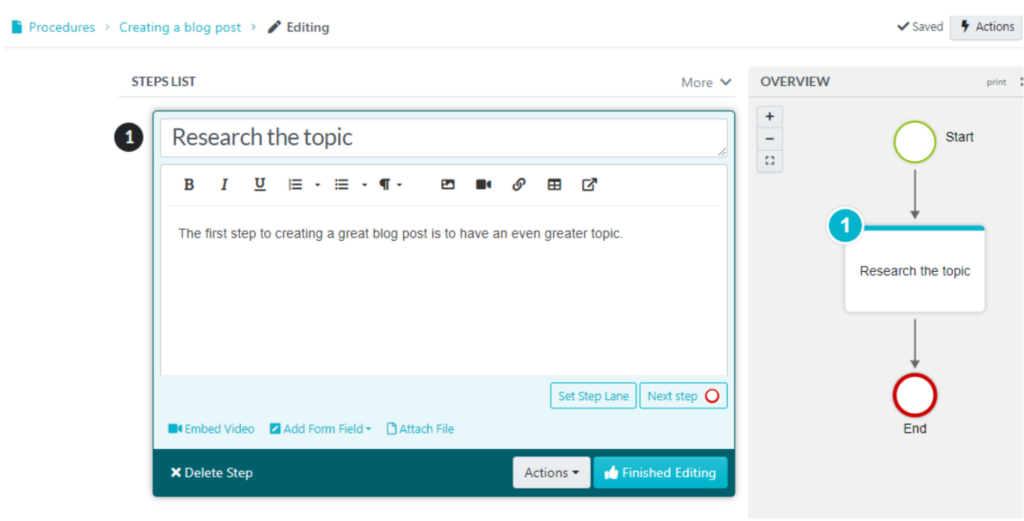
You can attach images, videos, links, tables, and other files in this editor. You can also embed video.
8. When you’re done, click on “Finished Editing.”

9. You can use the “Step” button to add as many new steps as you need.
10. Once your procedure is complete, click the “Approve” button to make it go live.
Instead, you can use all that time spent on non-essential or repetitive tasks to serve clients and build your practice.
If you don’t have permission, click the drop-down button and click on “Request Approval” so that whoever has such permission can approve the procedure.
Those are the simple steps to creating your procedure in SweetProcess. You can easily find your procedures by clicking on the Procedures tab in the navigation menu of your dashboard, and you’ll be taken to a list of your procedures.

You can click on whichever procedure you want to manage, and it will open up on a new page. From there, you can review and edit the procedure. You can also click the “Actions” button to add to a team, assign a task, share, etc.
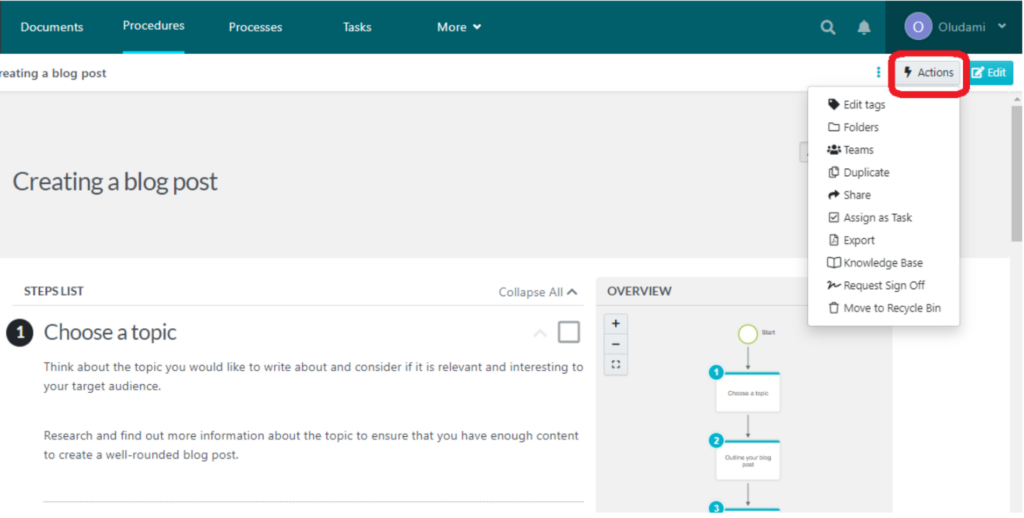
That’s how easy it is to create procedures on SweetProcess.
2. Create Comprehensive Company Policies
Another way to manage your small law firm using SweetProcess is to use it to create and manage your policies.
While procedures are step-by-step instructions to achieve a certain goal, policies are general rules used in making decisions and taking actions within an organization.
Policies are important because they give direction to your employees.
Here is how to use SweetProcess to create policies:
1. From your SweetProcess homepage, click on the “More” drop-down button and select “Policies.”

Next, click the “Create a new policy” button to create your policy from scratch. Or click the drop-down button at the top-right corner (beside “Create Policy”) and click on “Upload document” if you already have your policy in a Word document (.DOCX).
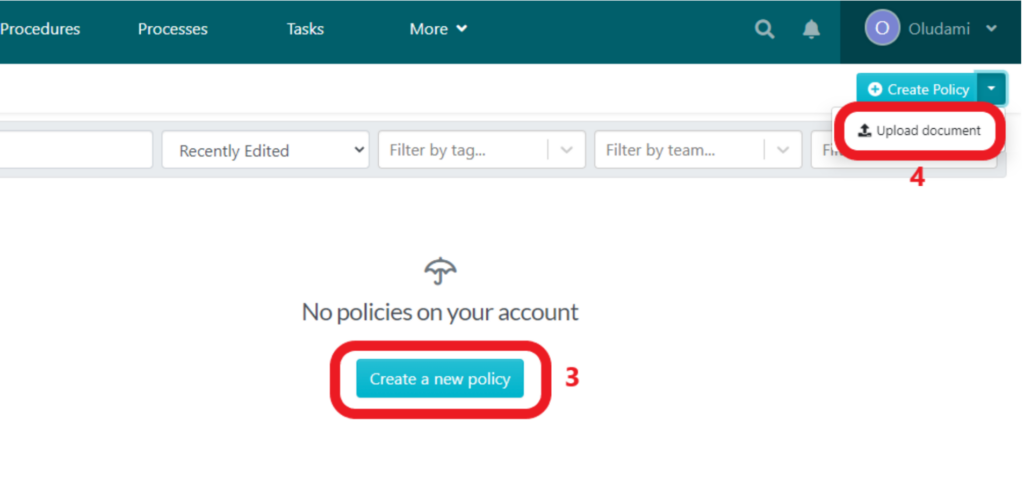
3. On the next page, enter your policy title. You can also add the policy to teams and folders. Next, click on “Continue” to get to the editor.

Or you can click “Write with SweetAI” to let SweetAI write the content based on your title.
4a. If you use SweetAI to write your policy, your policy draft is generated based on your title.
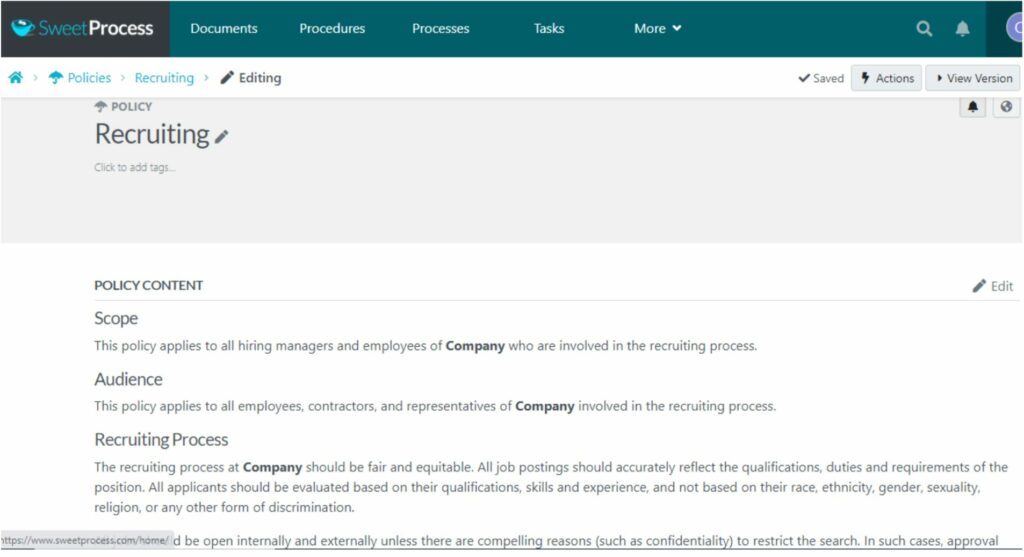
4b. If you click “Continue” instead of “Write with SweetAI,” you’ll be taken to the policy page where you can edit the policy to add content.
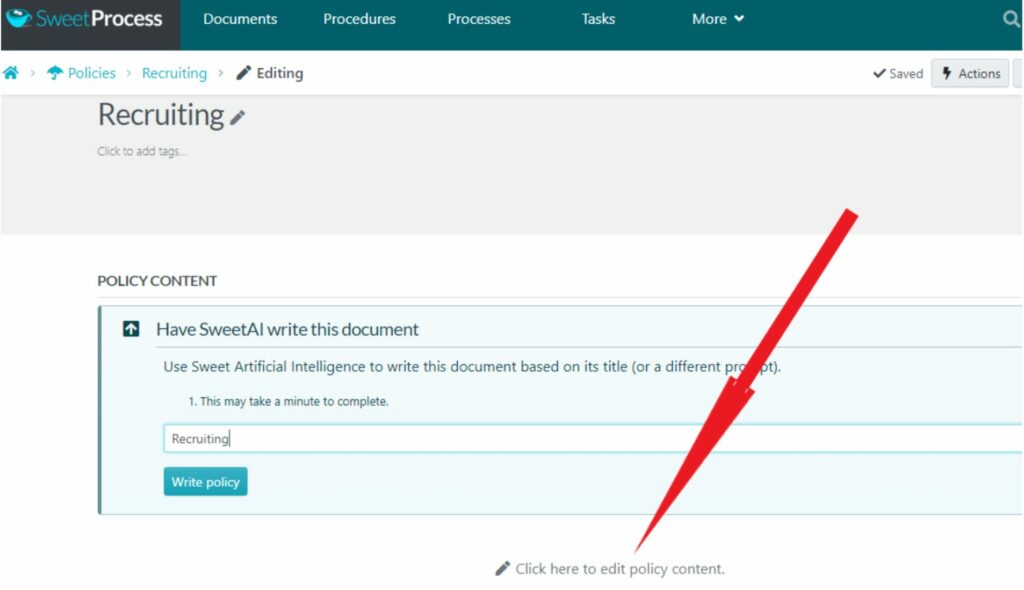
Note, however, that on the policy page, you’ll still get a prompt encouraging you to have SweetAI write your policy.
This is good when you don’t have your policy content ready; you can just fill in the blanks of the AI-generated policy.
5. But if your content is ready, you can ignore the prompt and click “Click here to edit policy content.”
6. This action immediately opens the content editor, where you can write or paste your policy content.
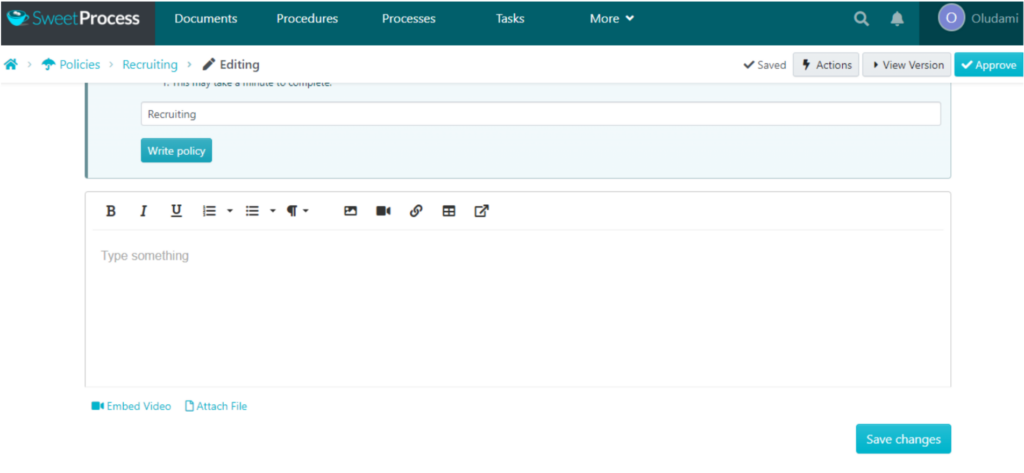
With this editor, you can include pictures, videos, links, and tables. You can embed a video on the page or attach an external file to the policy.
7. When done, click the “Save changes” button to save your policy content.
8. Next, click the “Approve” button at the top-right corner of the screen to approve your new policy and make it go live.
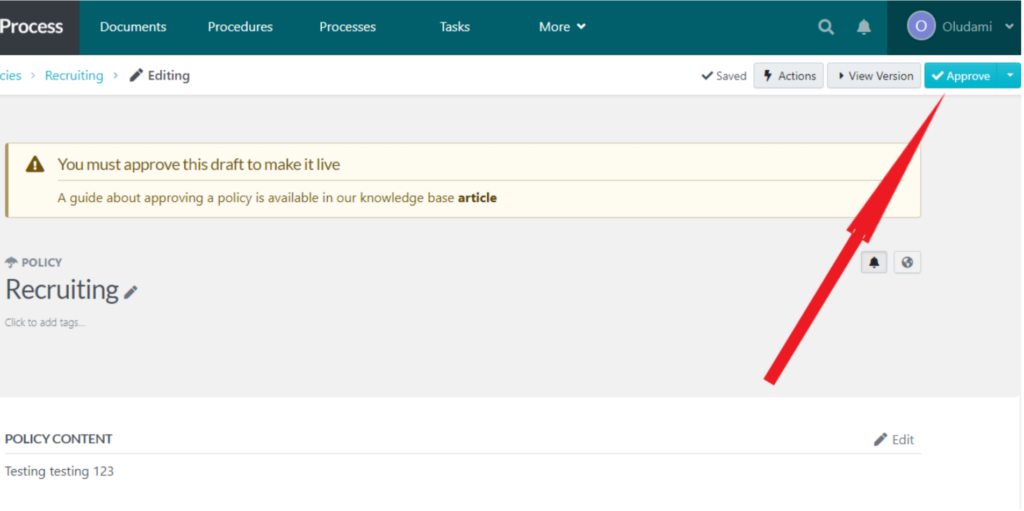
If you’re a team manager or super manager, you’ll automatically be able to approve the draft. Otherwise, you must request approval so that whoever has the authority can go into the policy to approve it.
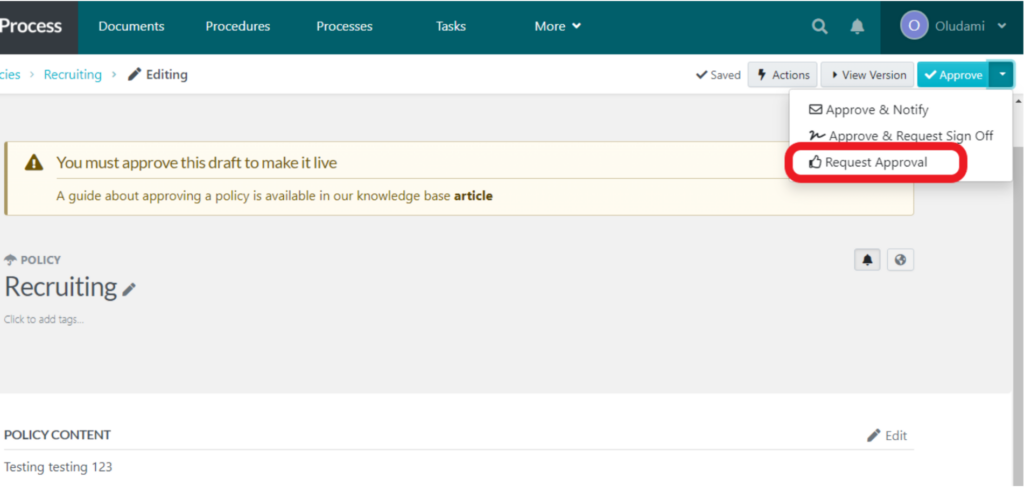
Once approved, your policy becomes live. Just as in procedures, you can find all your policies on the Policies page. This makes it easy to manage the policies however you deem fit.
And that’s the entire process of creating a policy on SweetProcess.
3. Turn Existing Procedures and Policies Into a Knowledge Base
Having a repository of how-tos for your team members is a great way to streamline your business operations. Employees can simply go to your repository to find a guide to help them achieve whatever they want.
This is what a knowledge base does for your organization.
A great starting point for creating a valuable go-to knowledge base for your small law firm team is turning your existing law firm procedures and policies into a knowledge base.
Here are the steps to turn your existing procedures and policies into a knowledge base in SweetProcess.
- From your SweetProcess home page, click on “More,” and in the drop-down select “Knowledge Bases.”
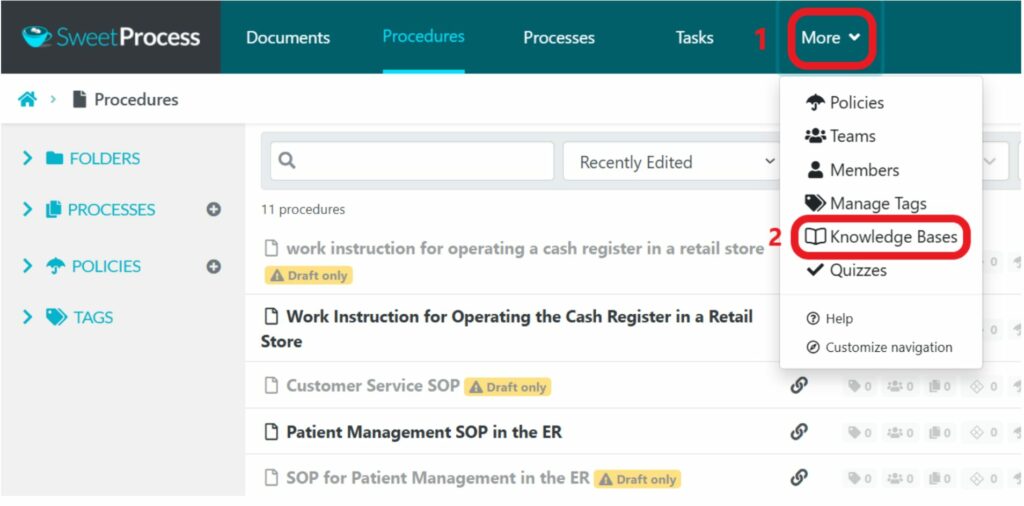
- On the Knowledge Bases page, click “Create Knowledge Base.”

2. Give your knowledge base a title and click “Continue.”

3. You’ll be taken to the new page of your new knowledge base, where you can set up things like the theme (for your knowledge base), control access, set feedback, customize your text blocks, set your knowledge base URL, and then finally create a category for your knowledge base to start creating it.
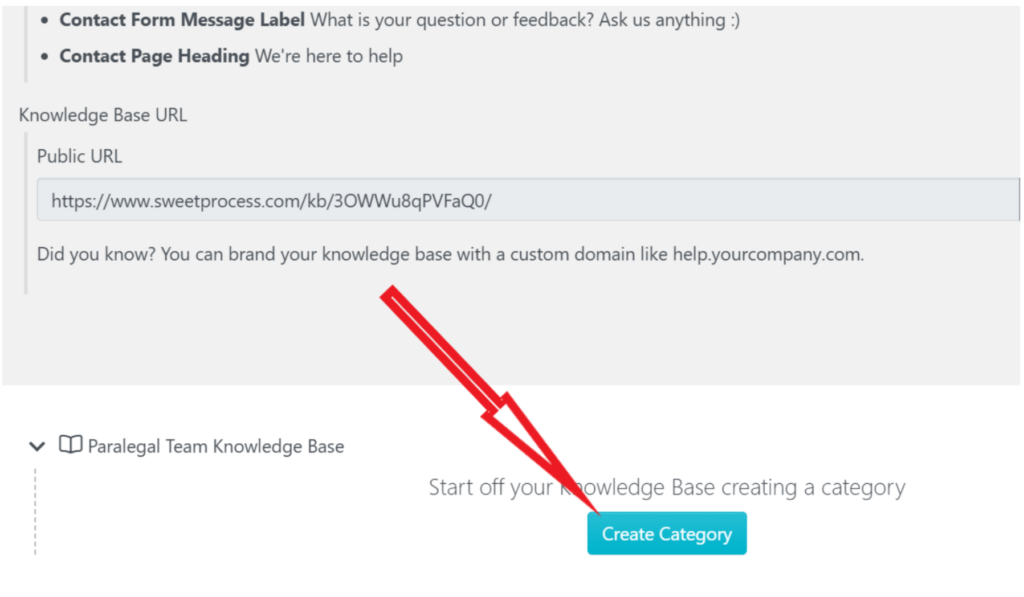
4. Next, click on the new category (folder) you just created, and from the drop-down menu and select “Add new Article.”
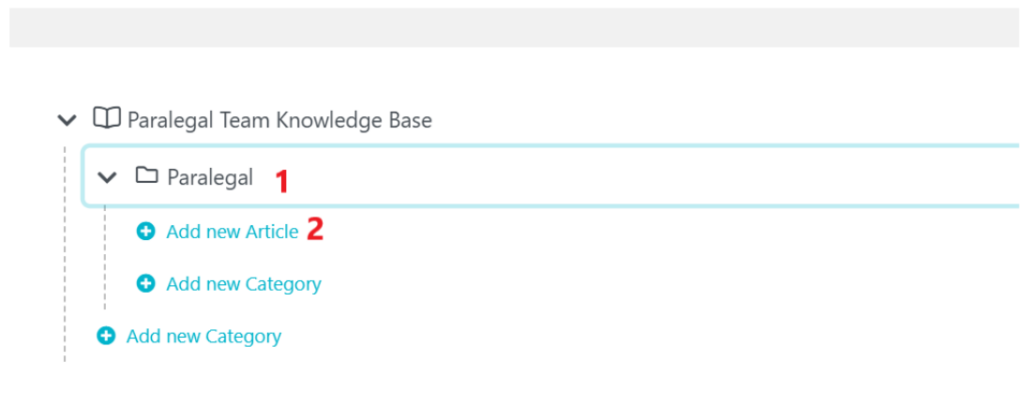
5. You will then be able to select the procedure or policy you want to add to your knowledge base.
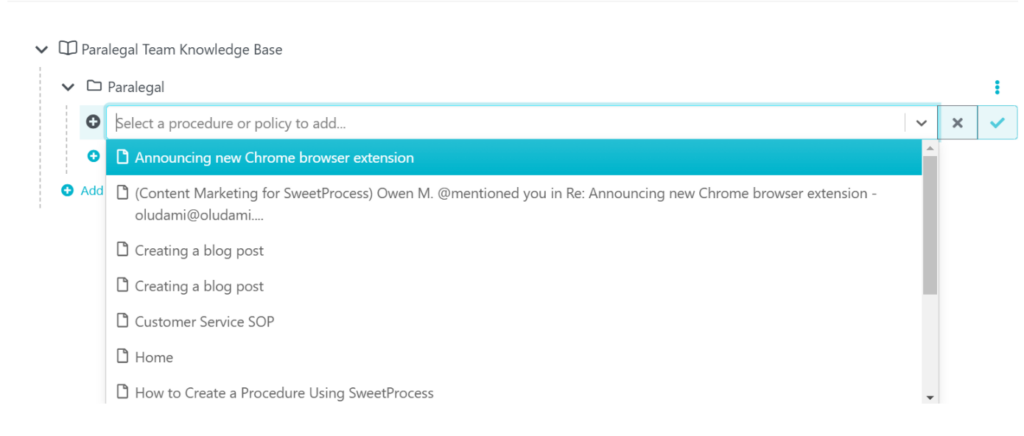
6. Select from the list fetched, then click on the green checkmark on the right to add the procedure or policy. You can keep clicking “Add New Article” to add as many procedures or policies as you want.
7. You can also either add a new sub-category (1 below) under an existing category by clicking “Add new Category” from the category dropdown or add an entirely new category (2 below) under the same knowledge base title by clicking “Add new Category” under the title drop-down and then follow steps 5 to 7 again.

You’ve then successfully converted your procedures and policies into a knowledge base, which is live and on your Knowledge Bases page.
You can manage your knowledge base—edit or delete documents and categories—by clicking on the three vertical dots by the extreme right of each.
You can scroll back up to the URL area, click on “Visit Knowledge Base” to preview your newly created knowledge base, and click on the scissors icon to copy the public URL/link.
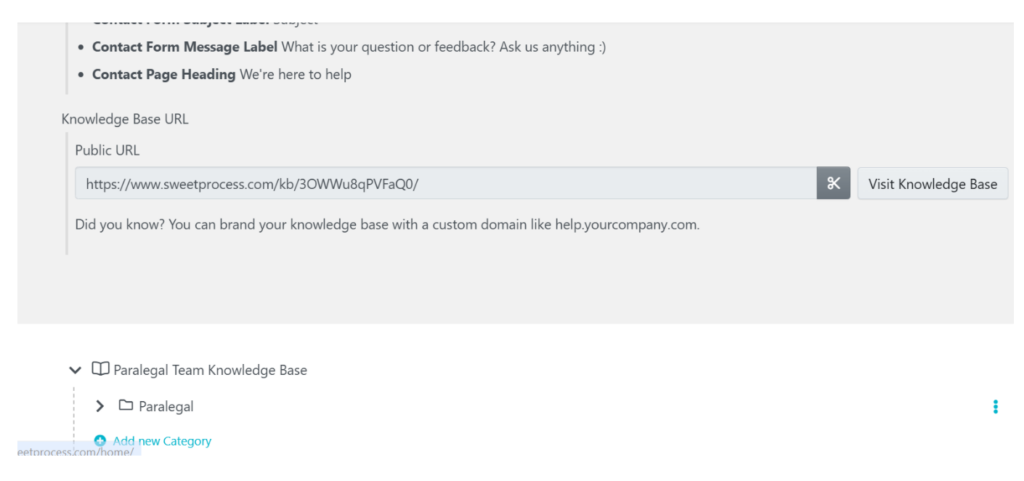
4. Build a Quiz to Assess Your Employee’s Grasp of the Firm’s Policies, Processes, and Procedures
You’ve done the hard work of documenting your small law firm’s processes, procedures, and policies and assigned them to your team. It’s now up to team members to either view and read through those documents or not.
No! You want to ensure that they actually do so—not just view the document but also learn the company policies and commit to heart the processes and procedures that concern them.
A quiz can help you achieve this; luckily, it comes packed with SweetProcess.
Here’s a step-by-step guide on building a quiz around your firm’s policies, processes, and procedures:
- From the menu at the top of your SweetProcess homepage, click “More” in the drop-down menu and select “Quizzes.”
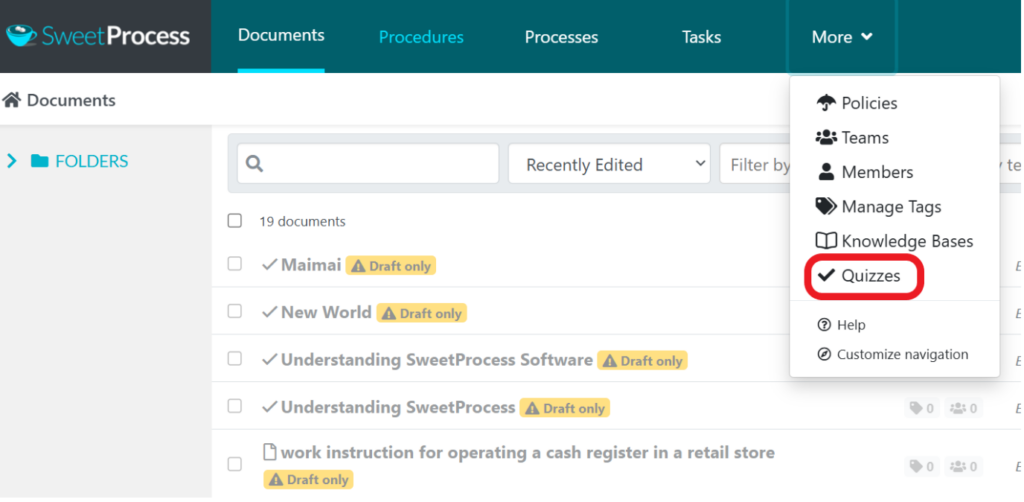
2. On the Quizzes page, click “Create Quiz.”

3. On the next page, you enter your quiz title (1), select a team to assign it to (2), and click on “Continue” (3), as seen below.

4. You’ll be taken to the page for this new quiz. Click anywhere around the title to edit the quiz (setup). You can edit the title, add quiz description, set the duration for the quiz, and set the pass mark.
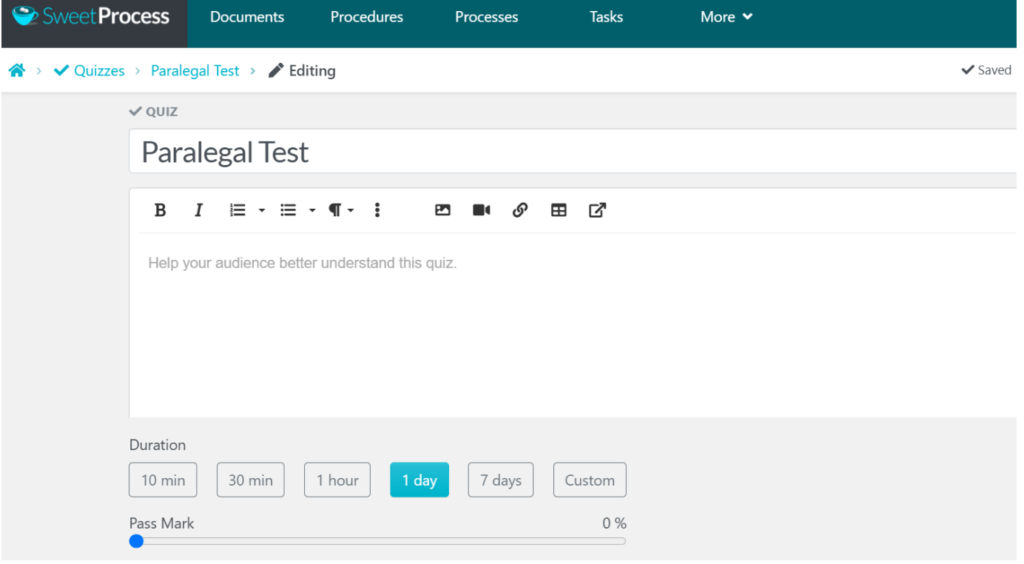
5. When you scroll down, you’ll also be able to attach any documents (procedure, process, or policy) you want to recommend in the quiz.
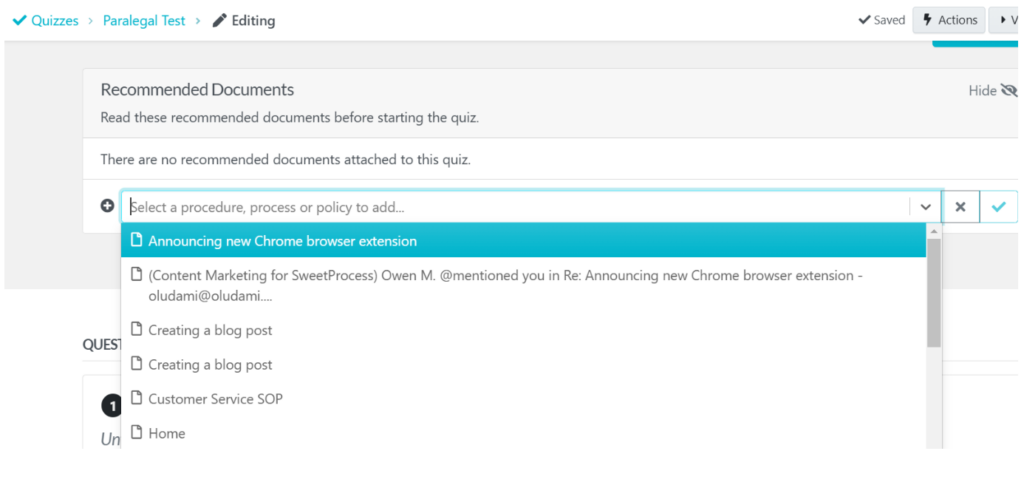
6. At the bottom of this page, you can add quiz questions. Your first question will be ready with its placeholders to be edited.
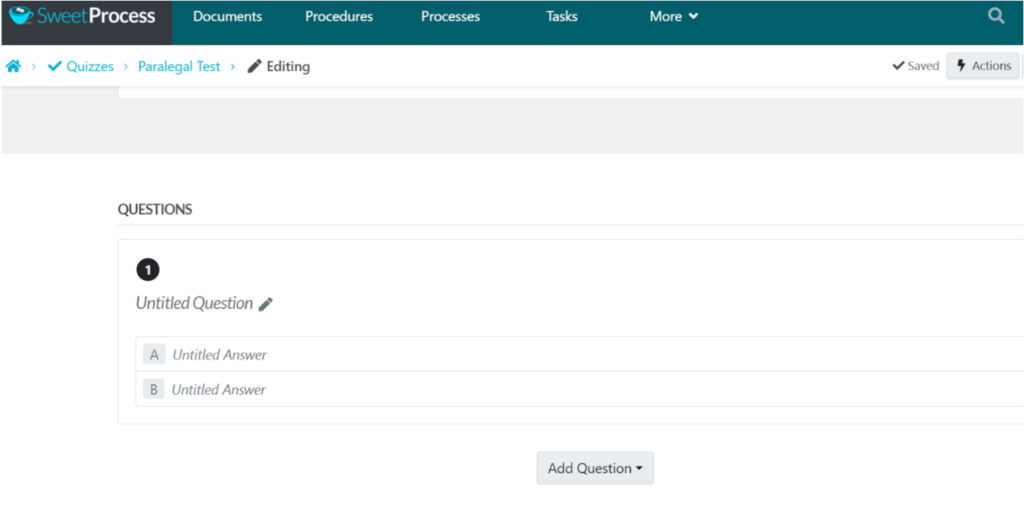
7. Click the edit pencil icon—or anywhere within the question box—to edit and input your first question and answer options. You will click the checkbox by the right of each answer to select which is correct.
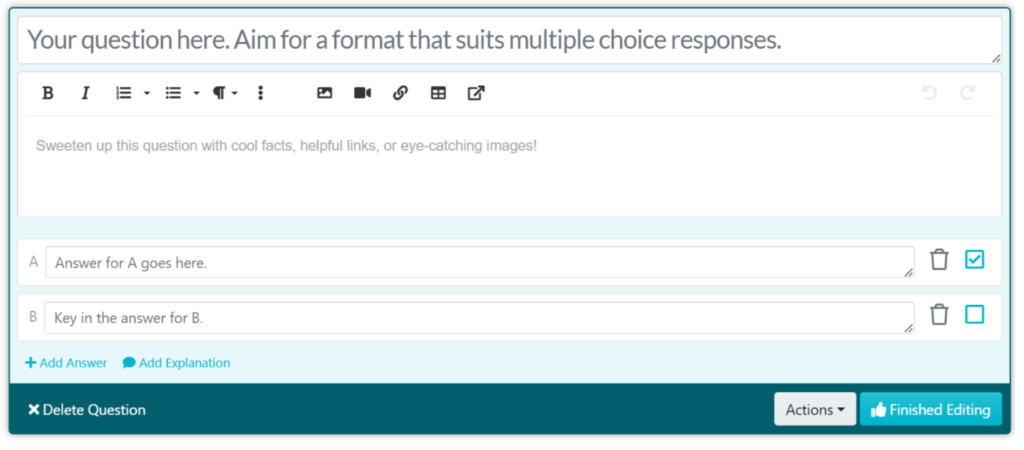
You’ll be able to add extra words, links, and images to your question and more answers by clicking “Add Answer.”

You can also click “Add Explanation” to explain to your team members why an answer is correct or incorrect.
8. Click on “Finished Editing” when you’re done, and you’ll get a preview of your quiz question.

You can click the “Add Question” button to add more questions to your quiz. You’ll be able to choose the kind of question, whether multiple choice or open-ended answer.
9. When you’re done setting up your quiz, click the “Approve” button at the top-right corner of the screen to make it live.

Once you do this, the quiz becomes accessible to members of the assigned team, and can be found on the Quizzes page.
This is how to set up a quiz to test your team’s knowledge of your small law firm’s processes, procedures, and policies.
5. Turn Procedures and Processes Into Actionable Tasks
It’s not enough for your employees to just know procedures and processes—they have to be able to implement them. It might help to turn some of your methods and processes into actionable tasks.
Here’s a quick tutorial on how to do that:
- From your SweetProcess navigation menu, click on “Tasks.” At the top-right corner of your screen, click on “Assign Task.”
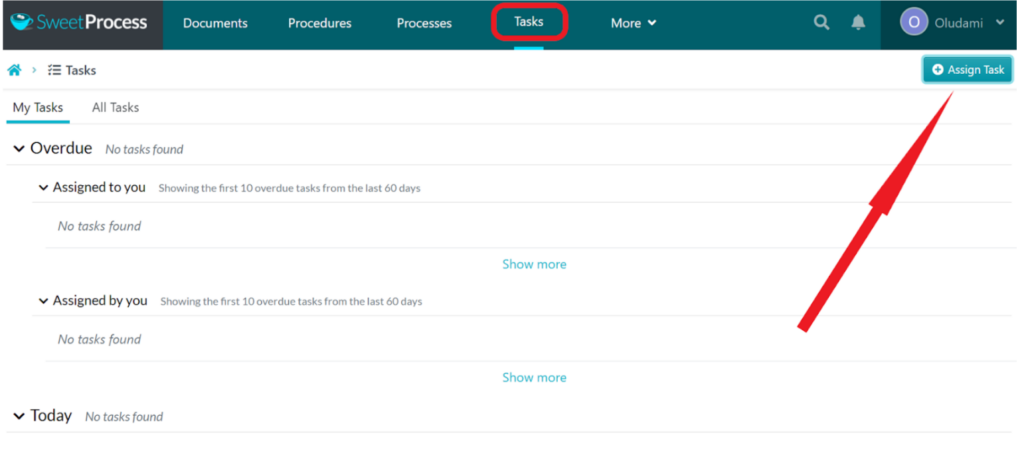
- A box will pop up on your screen from which you can set up and assign tasks. First, you’ll be asked to choose the process or procedure you want to turn into a task.

- Next, you can assign the task to teams and team members. You can assign teammates together or assign each teammate their task. You can even assign specific individual steps in a procedure or process.

You can assign to a team or a role and invite a new member to assign to someone not already in your SweetProcess account.
When you’re done assigning the task, click the “Next” button.
- The next step is to set a due date and recurring timeline. You can name your task, set the due date and time, and even add a start time if you wish. And you can also set a task repetition schedule at this stage.

Once you’ve set up your task, click on the “Assign Task ” button. Your task is ready and can be found listed on the Tasks page. To complete the task, the assignee must check off the procedure steps in sequential order.
Second Way
A second way to assign processes and procedures as tasks in SweetProcess is to open the process or procedure you want to assign as a task and, in the top-right corner, click on “Actions.” You’ll then see a drop-down list of the different actions you can take on that document, including assigning it as a task.
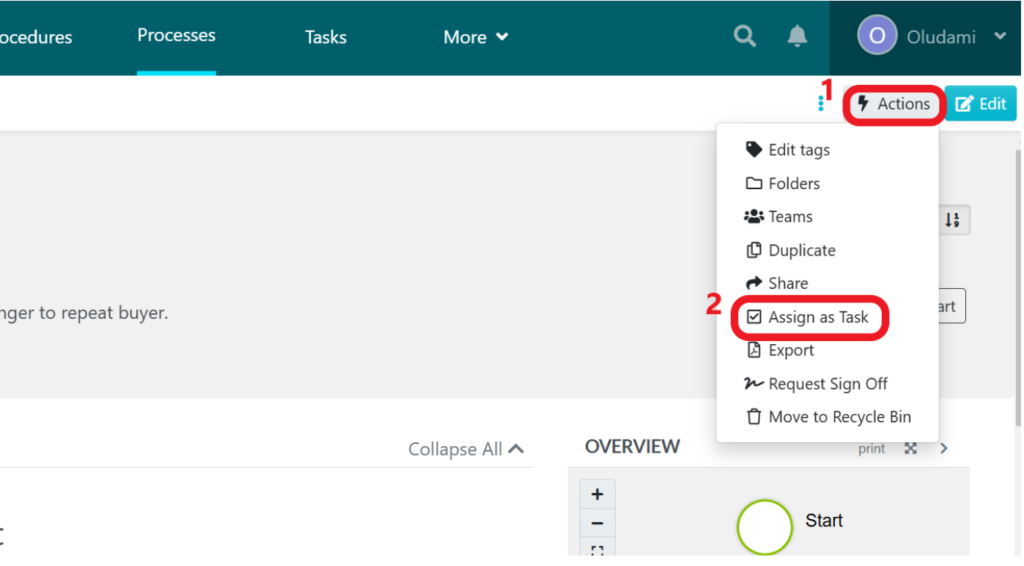
Simply click on “Assign as Task” from this list, and the same task popup as seen earlier will appear, but this time, the first step is automatically done—the task to assign is already chosen.
Third Way
The third way to assign a process or procedure as an actionable task is to go to the Procedures or Processes page, depending on where the task is located. Then, from the list of procedures or processes, click on the three vertical dots on the extreme right of the process or procedure you want to assign, and a drop-down list will appear.
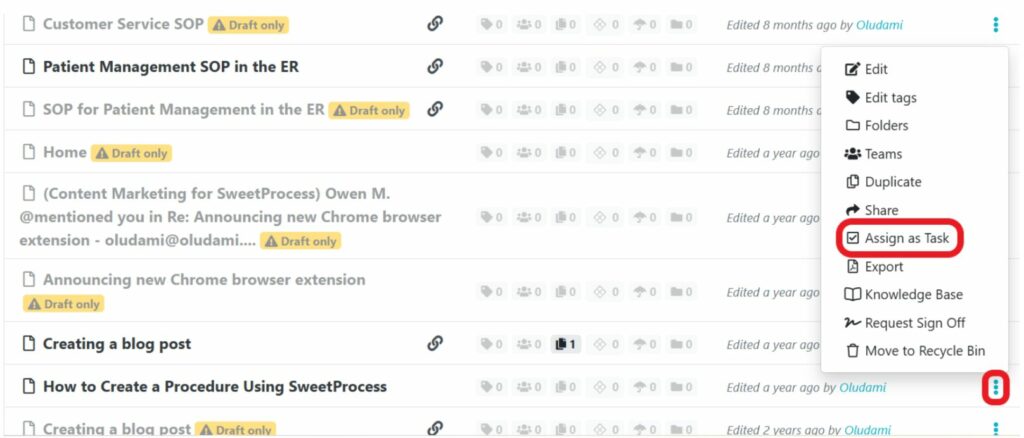
From this list, click on “Assign as Task,” and you can assign your process or procedure as a task, as described in the other methods above.
6. Track Employees’ Performances Across the Board
Are you interested in how your employees have been performing in accordance with your operations across the board? Want to see how they are handling the procedures, processes, and other tasks assigned to them? That’s easy with SweetProcess.
A quick way to do that is to go to your SweetProcess header and click “More” from the navigation menu. From the list that drops down, select “Members.”
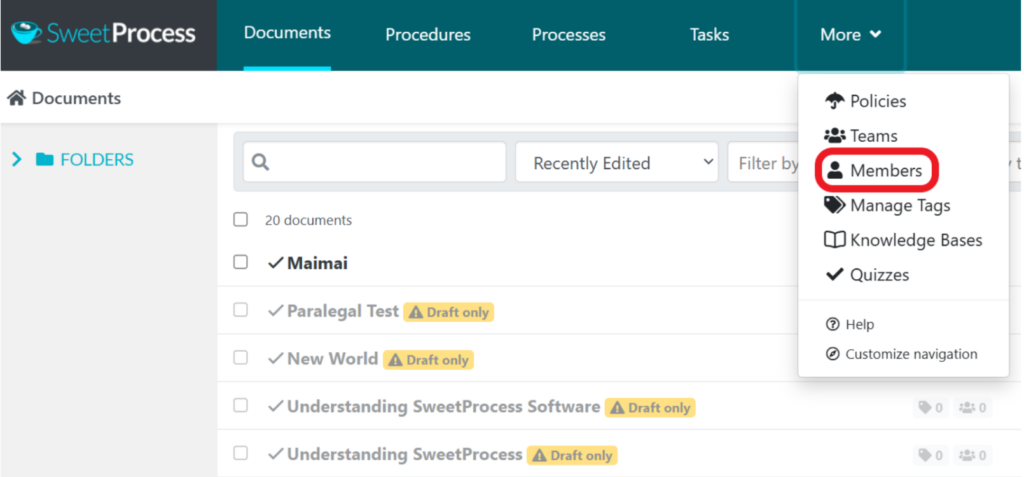
You’ll be taken to a list of your team members. Click on the one that interests you, and you’ll be able to see everything they’ve been up to inside SweetProcess, including the documents and other things they’ve been invited to collaborate on, the teams they belong to, procedures, policies, and processes they’ve worked on, and tasks they’ve signed off on.
When you click on the “Activity” tab, however, you’ll see a timeline of everything they’ve done on SweetProcess since they joined.
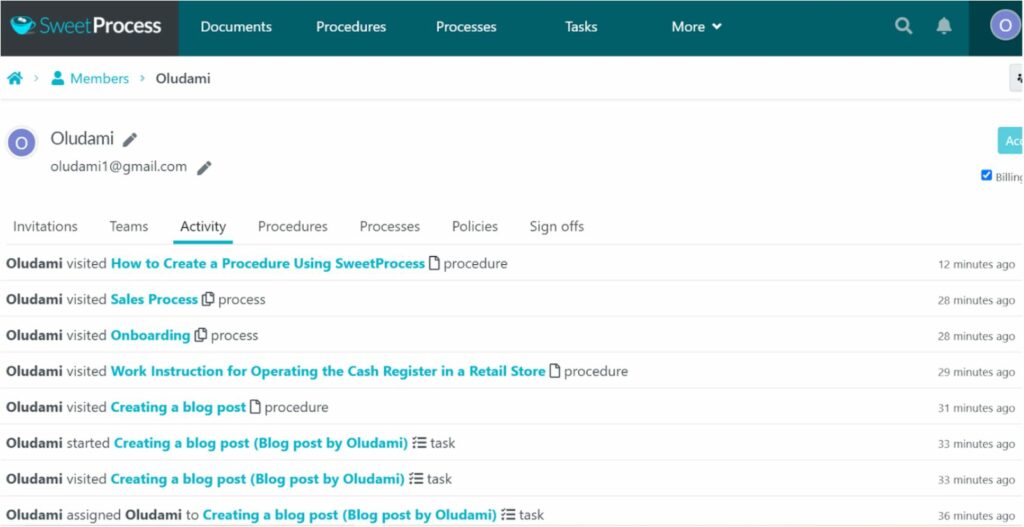
With these, you can track each employee’s performance across the board and know their standing within your firm.
Now that you’ve learned different ways to manage your small law firm operations using SweetProcess let’s check out a few law firms that have successfully done that.
Before that, however, you can immediately begin to put into practice some of the things you’ve just learned by trying SweetProcess for free for 14 days. No restrictions during the trial and no credit card is needed to get started. You get full access to all the amazing features of SweetProcess to help you streamline your operations and grow your business faster. Click here to get started now!
Why These Law Firms Chose SweetProcess to Manage Their Legal Operations
The biggest benefit of using SweetProcess is that it helps you streamline your operations. With streamlined operations comes increased productivity, effective organization, client satisfaction, and business growth.
There are many reasons why a law firm might want to choose SweetProcess to solve organizational problems. Following are a highlight of a few law firms who’ve used SweetProcess to manage their operations so we can learn why they needed SweetProcess in the first place, what made them choose SweetProcess out of all the options available, and most importantly, the results they’ve gotten so far from using SweetProcess.
1. Resolute Legal

First, let’s consider how Resolute Legal, a Canada-based law firm, successfully scaled up by using SweetProcess to create a structure for its business operations.
David Brannen, founder and managing lawyer at Resolute Legal, was driven by his passion for helping people with disabilities get the compensation they deserve. However, he needed to get his business up and running to achieve his goal. He was doing everything all by himself when he started his company in his bedroom, and the absence of a structure in his business hindered David from achieving his goal, which became a serious concern.
As David struggled with juggling all the tasks on his hands, he was advised that he would only be able to grow if he created a structure in his business. David saw reason in the advice and decided to take action by looking for an effective system.
A fellow lawyer who was conversant with SweetProcess mentioned it to David, and David checked it out. He looked into it, evaluated some other competitors, and saw that SweetProcess fit the bill as it is simple and easy to use—just what he wanted.
According to David, SweetProcess was responsible for him “scaling up from a lone dude doing his own thing to having a real business with a bunch of employees and going from the guy trying to do everything in a crazy frantic state to someone who’s pretty comfortable right now.”
Here are some of the specific ways that SweetProcess has impacted his business:
1. Employee Onboarding and Training
The moment David implemented SweetProcess in his business, he was pushed to hire employees who would champion his business goals. He started by hiring lawyers who would work with him and documented all their duties in the system without having to teach them every little detail in person. Once they saw the processes, they could run along with them.
2. Central Knowledge Base
SweetProcess has also been beneficial to the company in terms of knowledge transfer beyond employee onboarding and training.
David has built a knowledge base that helps employees stay informed about the latest work-related information at SweetProcess.
“I took all the duties that I had to do as a lawyer and did a SweetProcess of them…. We used it for other staff as well, and that did help expand their productivity with the other staff because they’re not constantly asking How do I do this?…”
3. Quality Control
An organization’s ability to be consistent in its services wins customers’ trust and loyalty as they are guaranteed good results every time.
Maintaining consistency in the organization has never been easier with SweetProcess. All that is needed is a SweetProcess of the procedures in question, and the rest will follow.
4. Streamlining Workflow
The many activities going on in the workplace could cause disorganization and confusion if not managed effectively.
SweetProcess helps David and his team to focus on what is important to them at every point. They can search for the specific procedures they need and have access to only the tasks that concern them so they do not get overwhelmed.
You can click here to read the full Resolute Legal case study and listen to David Brannen’s audio interview.
Get the Easiest Way to Streamline Your Business Operations Too
Deciding to streamline his business operations was a turning point for David. He was not just able to create a structure in his organization. He was also able to scale up and achieve his business goals.
2. Brooks Law Group

As administrator/HR at Brooks Law Group, a personal injury law firm specializing in assisting accident victims get the help they need within the confines of the law, Laura Johnson was already familiar with business processes. The firm had processes for rendering their services to injured and disabled people, but these processes were manually managed, and there was only so much they could do with them.
Employees were not able to work independently without seeking constant guidance from Laura. This dependency hindered efficiency and caused operational setbacks in the firm, and something needed to be done urgently.
Laura and the firm’s managing partner found SweetProcess, and it was an easy decision for them as they saw the features and abilities of SweetProcess in the demo they watched.
The switch to SweetProcess made the organization better in several ways:
1. Effective Business Process Documentation
Documenting business processes requires some tact, and without tools that guide them to stick to the essentials, organizations often end up documenting unnecessary information and creating redundant processes.
More important than documenting processes is having easy access to them. SweetProcess, with its simplified documentation features, has helped Brooks Law Group document processes effectively and make them easier to access.
2. Standardized Operations Across the Business
Thanks to SweetProcess’s easy access to organizational documents, employees across Brooks Law Group’s five offices work with the same procedures despite being in different locations. They access documents in the cloud from anywhere, at any time, and the management plans better, knowing everyone is in sync with their agenda.
3. Enhanced Learning and Training
Even the most intelligent and skilled workers usually need assistance getting the hang of things when they come into a new position or even a new organization. But since the switch to SweetProcess, according to Laura, “In the event that we onboard a new employee or an employee is assisting in an area that is not their norm, we point them to SweetProcess to find a directive.”
Being able to train new employees by simply directing them to SweetProcess was “liberating” for Laura.
4. Uninterrupted Workflow
It is in the best interest of any organization to keep its workflow running smoothly and uninterrupted by unforeseen circumstances.
Doing this manually is risky as the person executing the process may become unavoidably unavailable, and the firm suffers a setback. By using SweetProcess, however, whenever an employee is indisposed to perform their task, their colleagues can fill in for them seamlessly using the documented detailed processes as a guide.
These are some of how Brooks Law Group has been able to use SweetProcess to manage their law firm’s operations. You can read the full case study and listen to Laura’s interview here: Brooks Law Group Case Study.
Since they already had processes on the ground, all they had to do was transfer them into SweetProcess and then get them up to standard before introducing them to their staff.
You can improve your business processes with SweetProcess, too; this was the game-changer for Brooks Law Group. Luckily, you can get started immediately—without even having to put a credit card on file—by signing up here for a free 14-day trial of SweetProcess.
What happens when a document management software company for lawyers is itself in dire need of documented processes to get things done? That was the story of Optiable. Let’s consider how they improved performance and increased productivity with SweetProcess.
3. Optiable

CEO of Optiable, Craig Bayer, was micromanaging employees as part of his day’s job, and it was taking up a chunk of his time at the expense of other important tasks.
His company, which helps law firms leverage technology to streamline their workflow, needed to systemize its own operations. Craig and his team could not execute the simplest tasks and rest assured that all was well; there was always a chance that something was amiss.
Craig finally spoke to a friend who recommended SweetProcess to help him avoid burnout from his challenges. He checked it out and was immediately hooked by its features.
Here are a few ways SweetProcess helped the organization out:
1. Document Business Processes Comprehensively
Documentation is about providing helpful information on how to do things and then communicating it effectively to achieve its purpose. Craig had tried everything in the past, including Excel Sheets, Google Docs, Word documents, etc., but these tools didn’t make much impact.
With SweetProcess, however, it became easy to document their processes, with the ability to add media like videos and images where necessary to help employees understand them.
2. Organize Workflow and Increase Productivity
A disorganized workplace kills productivity, and Craig found it challenging to resume work every day. However, his story changed after he started using SweetProcess.
He said in his interview: “Now, everything is a lot more relaxed even though we are doing more work than we were doing before. Once you have everything in a list, it’s just a lot easier to work rather than not knowing what’s on that list. We don’t have that uncertainty anymore.”
3. Enhance Employee Efficiency
Inadequate work information will only make employees depend on you for everything, and this lack of confidence in their abilities to fully execute tasks quickly becomes a problem.
When they started documenting their business processes and procedures in SweetProcess, Craig was amazed at how his team began to get things done swiftly and independently.
4. Automate Recurring Tasks

Some recurring tasks may seem little, but they are an important part of business operations. They are, however, easy to forget when there are bigger tasks at hand, even when leaving them undone can negatively affect the entire organization.
With SweetProcess, Craig and his team could set recurring tasks on autopilot, and now they always just get done.
Now that the company has systematized its operations, its focus is on scaling up and taking on more new clients than would naturally be possible for a company its size. Craig believes that doing this is not only possible but easy.
You can read the full Optiable case study here and also listen to Craig’s interview.
You too can do more with less in your business when you systemize your operations with SweetProcess. All you have to do to get started is sign up for a 14-day free trial of SweetProcess.
To further help you manage your law firm effectively, let’s discuss a few more tips and best practices.
Tips & Best Practices for Effective Law Firm Management
Now that you know how to run a successful law firm, you know that it is all about balancing legal expertise with effective management, and we already discussed a few strategies for effective law firm management. More so, you now know how to use SweetProcess to manage a small law firm’s operations and have seen how other law firms are doing it.
In this section, we’ll be discussing additional tips and best practices for effective law firm management. Implementing the following best practices can help you build a thriving law practice:
1. Build Confidence
Building and inspiring confidence in your practice is one of the best things you can do for your small law firm. Confidence is the foundation of strong client relationships, as it demonstrates your competence and sets the tone for how your team and clients perceive your firm.
How can you build confidence in your practice?
First, showcase your expertise and reflect it throughout your practice—even in management. Regularly update your knowledge of the law to remain current and relevant in your practice specialties. Ensure that you communicate your expertise both while consulting with your clients, a prospective client, and during court proceedings.
Confidence doesn’t come from just learning; it grows with experience, too. Therefore, you must be confident in yourself and trust your judgment to lead your team effectively. If you make mistakes along the way, take ownership of your decisions and learn from them.
2. Adaptability
Apart from constantly updating your knowledge of the law, you must also always stay abreast of changes in the industry—in law, technology, trends, client needs, and expectations. This ensures that your small law firm remains competitive and relevant.
Monitor industry trends and keep an eye out for emerging practices. Anticipate changes in your practice areas and adjust your strategies accordingly to remain ahead of the competition.
Finally, be open to embracing new technologies, like AI tools and case management software.
3. Foster a Client-Focused Approach
Prioritizing your clients’ needs and satisfaction above all else will help you build trust and drive repeat business. Your clients are the lifeblood of your small law firm; give them the best experience, and referrals will flood in.
Be accessible enough to promptly address client inquiries and provide regular updates as their case progresses to show them that you value them, their time, and their concerns. When explaining legal processes to them, avoid potentially confusing jargon and use plain language instead.
A well-structured client intake form can streamline onboarding, helping you gather essential details efficiently while demonstrating professionalism. By designing your client intake form thoughtfully, you ensure that each client’s unique circumstances are considered when offering solutions. Tailoring your approach to their preferences and ultimate goals fosters trust and long-term relationships.
4. Cultivate Business Acumen
A law firm is also a business in the legal industry, not just a legal practice. And like any other business, beyond its technical aspect, understanding and managing the financial and operational aspects of your small law firm is crucial to its success.
You must understand and track your firm’s financial metrics, from revenue to expenses and even profitability, to identify areas for improvement. To truly grow your practice, you must also invest in marketing. You can develop a strong online presence through a professional website, social media, and strategies like search engine optimization to always attract a new client.
5. Inspire and Motivate Your Team

The morale of your team directly impacts the productivity of your small law firm. A happy and motivated team will exceed your expectations and deliver excellent results for your clients. You should recognize and celebrate each team win, big or small, in court or in daily operations.
Also, provide your team members with training, programs for career advancement, and other growth opportunities to improve them and make them invested in the firm’s success.
Most importantly, inspire and motivate them with your own life. Lead them by example by demonstrating integrity, dedication, hard work, and professionalism in your work, and your team will be inspired.
6. Prioritize Organizational Skills
Organizing your small law firm effectively is important for successfully managing it, as it helps you to prevent avoidable errors like missed deadlines and ultimate client dissatisfaction.
Organizational skills like time management, decision-making, delegation, communication, and collaboration will help you manage your law firm effectively.
Use existing technology to keep your small law firm organized. Tools like case management software, project management software, IM software, shared calendars, document management, and storage software can keep your firm organized and your clients happy.
Use a tool like SweetProcess to streamline your operations and manage your small law firm effectively. You can use SweetProcess to create standard operating procedures (SOPs), workflows for tasks, and checklists for repetitive ones, all to ensure consistency and organization.
7. Leverage a Data-Informed Strategy
Making operational decisions for your small law firm based on available data will help you create smart strategies, optimize your operations, and measure your success effectively.
First, you want to set attainable and measurable goals based on insights from your data. You also want to set benchmarks and KPIs to evaluate regularly to ensure your small law firm is on track.
You don’t want to just set goals and benchmarks; you also want to regularly track your results to ensure you’re hitting those goals. However, focus on important metrics like client retention rates and revenue per case/client. This will help you assess your law firm’s performance effectively.
You can also use external data to make operational decisions. You should analyze trends to identify changes in client behavior and adjust your operations accordingly.
The above tips and best practices will help to position your small law firm for long-term success.
Set Your Law Firm Up for Success With SweetProcess
Congratulations on getting to the end of this article. As promised at the beginning, you’re now equipped with the knowledge and tools you need for your small law firm management
Once you implement these strategies, your business operations will not just run smoothly; your employees will be happy to work with you, and your clients will be happy and satisfied with the work you put out.
Now that you know how to manage a law practice effectively, you know that an important part of this is leveraging relevant technological tools that will improve your work and consequent output. From case management software to instant messaging (IM) and collaboration platforms to shared calendars and document management tools, tech is vital to effectively managing your operations.
One tool that will make your life easier as a small law firm owner is SweetProcess. Using SweetProcess will make it extremely easy for you to get your team on the same page, streamline your operations, and grow your business faster.
You’ve seen how you can use SweetProcess to document repetitive procedures and give your team members clarity of roles and tasks, ensuring consistency in outcomes and improving efficiency. You’ve also seen how you can use SweetProcess to create your policies to give your entire organization direction and keep your firm compliant.
That’s not all; you’ve seen how easily you can turn your procedures and processes into a knowledge base your team members can run to when stuck, or a quiz to assess their grasp of your processes, or into actionable tasks to help them implement effectively, while you track their performance across the board.
Most importantly, you’ve seen how a few other firms have used SweetProcess to streamline their operations, boost productivity, and grow their businesses faster than they otherwise would without SweetProcess.
Therefore, it becomes apparent that SweetProcess is a must-have for any organization that wants to move faster toward its goals without experiencing burnout among employees or management.
You don’t even have to be convinced by anything you’ve read here about SweetProcess; its proof is in its pudding.
